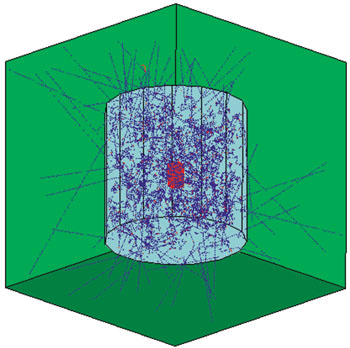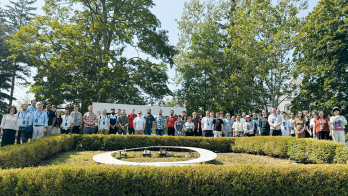Unveiling the nature of dark matter matter revealing itself only via its gravitational interaction is a continuous challenge in contemporary cosmology. The job of particle physics experiments is to search for the material of this vital but invisible matter. A recent meeting in Heidelberg surveyed the dark matter scene.

The invisible dark matter of the universe weighs heavily on cosmology. However, whatever and wherever this invisible material is, it must be made of something, and the most plausible candidates are relic particles from the early phase of the universe. The search for dark matter, mostly using non-accelerator experiments, has become an established part of particle physics.
These questions were examined when physicists from all over the world met in Heidelberg for the Second International Conference on Dark Matter in Astro- and Particle Physics (DARK98). The goal was to shed light on theoretical backgrounds from particle physics and cosmology, to discuss the results of dark matter detection experiments and to examine future projects.
The most compelling evidence for both baryonic (nuclear) and non-baryonic dark matter comes from observations of the rotation curves of galaxies. In particular, the rotation curves of dwarf spirals are completely dark matter dominated, pointed out Andreas Burkert (Heidelberg). The rotation curve of one of the best measured dwarf spirals can only be fitted to theoretical predictions if both an outer cold dark matter halo and an inner spherical distribution of massive compact baryonic objects (MACHOs) is assumed.
The search for MACHOs in the halo of our own galaxy in the form of planets, white and brown dwarfs or primordial black holes exploits the gravitational microlensing effect the temporary brightening of a background star as an unseen object passes close to the line of sight. For several years a number of groups have been monitoring the brightness of millions of stars in the Magellanic clouds, as Kim Griest (San Diego) and Marc Moniez (Orsay) explained.
MACHOs or WIMPs?
Several candidates have already been detected and if interpreted as dark matter would make up half of the amount needed in the galactic halo. However, no stellar candidate seems to be able to explain the observations. MACHOs could be an exotic form of baryonic matter, like primordial black holes, or they could be located outside the halo of our galaxy.
The leading non-baryonic dark matter candidates are the so-called weakly interacting massive particles (WIMPs). If WIMPs populate the halo of our galaxy, they could be detected directly in laboratory experiments, or indirectly through their annihilation products in the halo the centre of the Sun or Earth.
Blas Cabrera (Stanford) gave an overview of the direct detection experiments. The goal is to look for the elastic scattering of WIMPs off nuclei in a low-background target detector. The Stanford Cold Dark Matter Search (CDMS) experiment, he explained, uses detectors of ultrapure germanium and silicon operated at a temperature of 20 mK. The simultaneous measurement of both ionization and phonon signals allows nuclear recoil events to be differentiated from electron interactions a very effective background suppression method. For the moment, the experiment is located at the Stanford Underground Facility, 10.6 m below ground, but the goal is to operate the detector in the deep Soudan mine in Minnesota.
The DAMA experiment, presented by Rita Bernabei (Rome), is running 115.5 kg of sodium iodide detectors in the Gran Sasso underground laboratory near Rome. Its high statistics open the possibility of looking for WIMPs via a variation in the event rate owing to the movement of the Sun in the galactic halo and the Earth’s rotation around the Sun. The analysis of about 13 kg/yr reveals a positive WIMP annual modulation signal, which meanwhile has been confirmed with higher statistics from 54 kg/yr. However, a further confirmation by DAMA and by other experiments must be awaited.
The Heidelberg group reported on the two most sensitive germanium experiments the HeidelbergMoscow experiment and Heidelberg Dark Matter Search (HDMS) both of which are located in the Gran Sasso Laboratory. The HeidelbergMoscow experiment, which also searches for neutrinoless double beta decay in enriched germanium-76, currently gives the most stringent limits on WIMPnucleon scattering for raw data.
HDMS, a dedicated dark matter experiment, aims to improve this limit by one order of magnitude. Like the HeidelbergMoscow experiment, it looks for a small ionization signal inside a high-purity germanium crystal.

With the expected sensitivity, HDMS will be able to test, like CDMS, the complete DAMA evidence region. The new project of the Heidelberg group, GENIUS, presented by Laura Baudis, aims for a sensitivity that is a thousand times as good as that of present experiments. GENIUS will operate in its dark matter version 40 “naked” germanium crystals (100 kg) in a 12 x 12 m tank of liquid nitrogen. Reaching the target sensitivity, it could test almost the complete parameter space predicted for certain supersymmetric particles, thus deciding whether WIMPs make up the dominant part of our galactic halo.
Terrestrial indirect detection experiments search for high-energetic neutrinos as annihilation products of WIMPs in the centre of the Earth or the Sun. The MACRO experiment in Gran Sasso looks for an excess of neutrino induced upward-going muons, explained Teresa Montaruli (Bari). No WIMP annihilation signal has been found, but the sensitivity of the experiment sets stringent upper limits on the flux of upward-going muons and thus excludes significant portions of the parameter space predicted for the supersymmetric particles.
An alternative indirect signature for dark matter particles would be a distorted spectrum of secondary antiprotons owing to the pair annihilation of neutralinos in the halo. Pierre Salati (Annecy) compared the measured low-energetic antiproton flux by the BESS balloon experiment with theoretical predicted fluxes. While there is some room left for a possible signal of exotic origin, this cannot be seen as evidence for a supersymmetry induced signal, he claimed. To disentangle such a signal from the secondary antiproton flux much more sensitive detectors, like the Alpha Magnetic Spectrometer (AMS), are needed.
Superheavy dark matter
Recently a new class of dark matter candidates superheavy dark matter have emerged. If one gives up the assumption that the particle was in thermal equilibrium in the early universe, explained Edward Kolb (Chicago), then its present abundance is no longer determined by annihilation and much heavier particles the formidable sounding WIMPZILLAs are allowed. There are two necessary conditions for WIMPZILLAs: they must be stable, or at least have a lifetime much greater than the age of the universe; and their interaction rate must be sufficiently weak that thermal equilibrium with the primordial plasma was never obtained. Kolb presented a number of ways in which such a particle could have been created, like gravitational production during the transition between an inflationary and a matter- or radiation-dominated universe, and during the defrosting phase after inflation.
Like the new millennium, dark matter could be just around the corner. The next meeting DARK2000 will take place in Heidelberg. DARK98 was organized by H V Klapdor-Kleingrothaus (with Laura Baudis as scientific secretary) from the Max Planck Institut für Kernphysik, Heidelberg.







